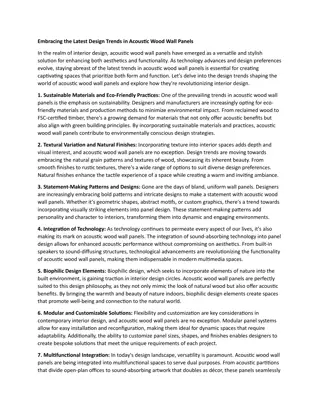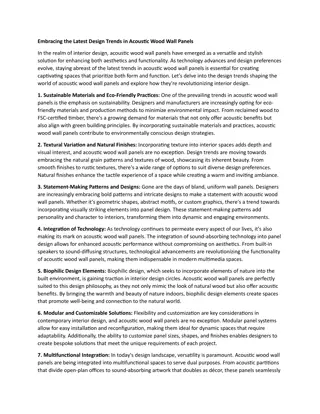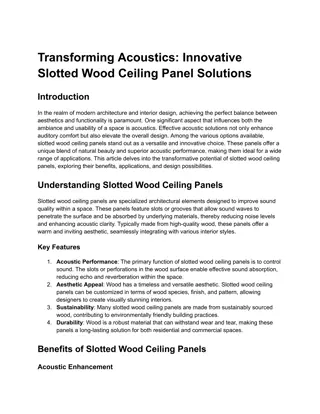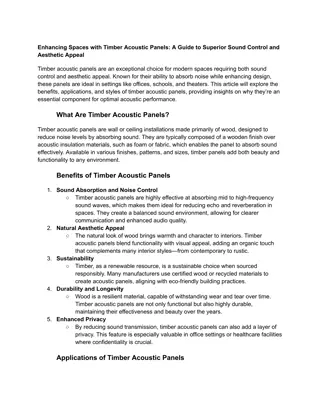
The Aesthetic and Acoustic Benefits of Acoustic Wood Paneling_ A Comprehensive Guide
Acoustic wood paneling has become a popular choice for architects, interior designers, and homeowners alike, offering a unique blend of beauty and functionality. By combining natural wood's timeless appeal with advanced acoustic properties, these pan
Download Presentation

Please find below an Image/Link to download the presentation.
The content on the website is provided AS IS for your information and personal use only. It may not be sold, licensed, or shared on other websites without obtaining consent from the author. If you encounter any issues during the download, it is possible that the publisher has removed the file from their server.
You are allowed to download the files provided on this website for personal or commercial use, subject to the condition that they are used lawfully. All files are the property of their respective owners.
The content on the website is provided AS IS for your information and personal use only. It may not be sold, licensed, or shared on other websites without obtaining consent from the author.
E N D
Presentation Transcript
The Aesthetic and Acoustic Benefits of Acoustic Wood Paneling: A Comprehensive Guide Acoustic wood paneling has become a popular choice for architects, interior designers, and homeowners alike, offering a unique blend of beauty and functionality. By combining natural wood's timeless appeal with advanced acoustic properties, these panels provide a solution for noise control while enhancing the aesthetic quality of any space. Whether it's a commercial building, a residential area, or a public venue, acoustic wood paneling serves as an elegant yet practical addition. This article will explore the many benefits of acoustic wood paneling, its different types, and how it contributes to creating a serene and visually pleasing environment. 1. Understanding Acoustic Wood Paneling Acoustic wood paneling refers to wood-based panels designed to reduce noise and improve sound quality within a space. Unlike traditional wooden panels, which primarily serve aesthetic purposes, acoustic wood panels are engineered with sound-absorbing properties. This makes them an ideal choice for spaces like offices, auditoriums, theaters, restaurants, and even homes where noise levels can disrupt the atmosphere. The panels are made of high-quality wood or wood-like materials and are designed with grooves, perforations, or slats that allow sound waves to pass through and dissipate, reducing echoes and reverberation. They are typically mounted on walls or ceilings and offer both visual appeal and acoustic functionality. 2. Acoustic Benefits of Wood Paneling Acoustic wood paneling is particularly effective in spaces where sound clarity is important. Whether in a large hall, office, or home theater, sound quality can be significantly improved by reducing unwanted echoes and background noise. Here are some specific acoustic advantages: Noise Reduction: Acoustic wood panels absorb sound waves, reducing overall noise levels in a room. This is especially useful in busy environments like offices, where noise levels can hinder productivity. Improved Sound Clarity: In spaces like conference rooms, lecture halls, or concert venues, the panels help in minimizing sound reflections, improving speech intelligibility and enhancing the experience for the audience. Minimizing Echo: Large, open areas often suffer from excessive echoes, making it difficult to hear clearly. Acoustic wood paneling helps reduce these echoes, creating a more pleasant acoustic environment. 3. Aesthetic Appeal of Acoustic Wood Paneling Beyond its acoustic benefits, acoustic wood paneling offers unparalleled aesthetic value. The natural look of wood adds warmth and sophistication to any space, creating a visually striking
environment. These panels are available in various finishes, patterns, and wood types, allowing designers and architects to match them with different interior styles. Natural Warmth and Beauty: Wood is a versatile material that blends seamlessly with modern, rustic, or traditional decor. Acoustic wood paneling can be customized in a variety of shades and textures to fit the design needs of any space. Customizable Designs: Whether you prefer clean lines, rustic charm, or something more contemporary, acoustic wood panels can be designed to suit your aesthetic vision. From slatted designs to perforated patterns, the panels can be tailored to enhance the visual appeal of any room. Sustainable Choices: Many acoustic wood panels are made from sustainable materials, making them an eco-friendly choice. For those seeking green design solutions, the use of responsibly sourced wood or recycled wood products can meet both aesthetic and environmental goals. 4. Types of Acoustic Wood Paneling Acoustic wood panels come in several different types, each designed to meet specific aesthetic and acoustic requirements. Some common options include: Slatted Wood Panels: These panels consist of vertical or horizontal slats, which are placed at regular intervals. The spaces between the slats allow sound waves to pass through and dissipate, reducing reverberation and echo. Grooved Panels: Grooved wood panels feature evenly spaced grooves that break up sound waves, making them ideal for noise control in large spaces. They offer a sleek, modern look that fits well in contemporary design settings. Perforated Panels: Perforated wood panels contain tiny holes or perforations that absorb sound and reduce echo. These panels can be customized with various hole sizes and patterns, providing a unique visual and acoustic solution. Micro-Perforated Panels: A more advanced version of perforated panels, these contain smaller, less noticeable holes that offer similar acoustic benefits without compromising on the aesthetic appearance. These are often preferred in high-end designs where subtlety is key. 5. Applications of Acoustic Wood Paneling Acoustic wood paneling is versatile and can be applied in various settings. Some common uses include: Offices: In modern office spaces, noise reduction is essential for maintaining productivity. Acoustic wood panels can be used to control sound in open-plan offices, meeting rooms, and conference halls, creating a more focused and quiet environment. Educational Institutions: Schools and universities often use acoustic wood paneling in lecture halls and classrooms to enhance speech clarity and reduce noise, ensuring students can focus on lessons without distractions.
Theaters and Auditoriums: Acoustic quality is critical in entertainment venues. Wood paneling enhances sound clarity and provides an immersive auditory experience for audiences. Residential Spaces: Home theaters, living rooms, and dining areas can benefit from the aesthetic and acoustic qualities of wood panels. These spaces often suffer from poor sound clarity due to hard surfaces, but acoustic wood paneling can offer a solution. Restaurants and Hospitality: Acoustic wood panel is frequently used in restaurants and hotels to create a pleasant atmosphere for guests. By reducing background noise, it allows for better conversation and a more enjoyable dining experience. 6. Conclusion: Why Choose Acoustic Wood Paneling Acoustic wood paneling is an excellent investment for any space, combining sound control with aesthetic appeal. Whether you re looking to reduce noise in a busy office or add a touch of sophistication to a home theater, these panels provide a perfect solution. With their ability to reduce noise, enhance sound clarity, and add warmth and beauty to any room, acoustic wood paneling offers a unique blend of form and function. The wide range of design options and the sustainable nature of wood materials make it a preferred choice for modern, eco-conscious spaces. As acoustic wood paneling continues to evolve in design and functionality, its versatility ensures that it remains a timeless and practical choice for enhancing both the acoustic and visual appeal of any environment.






















